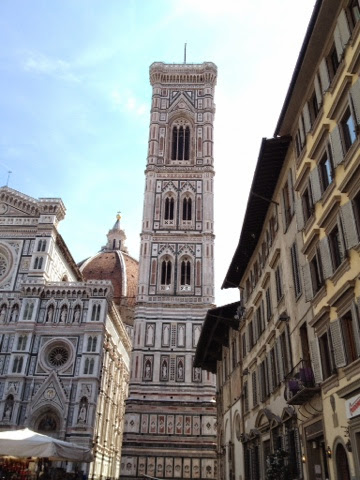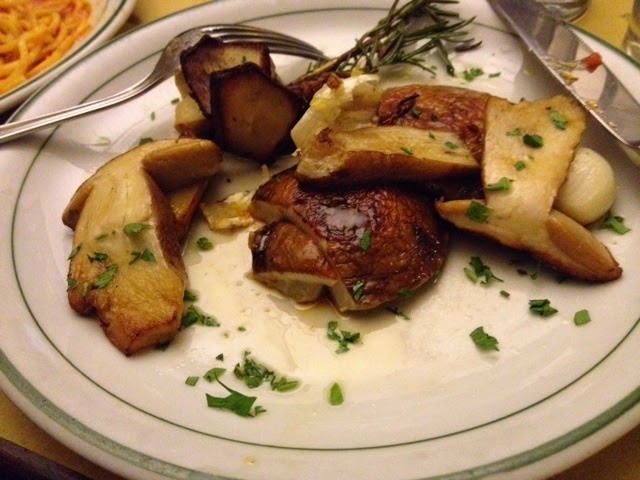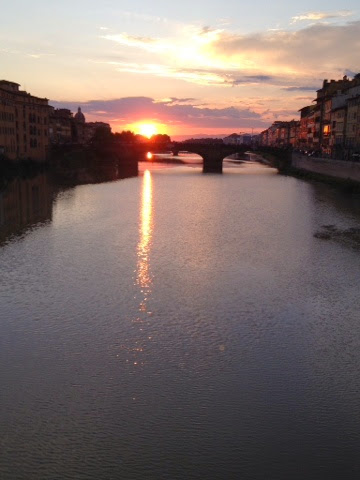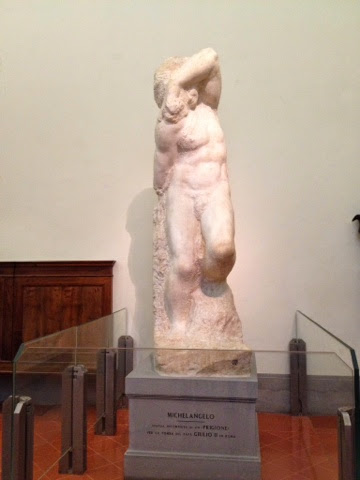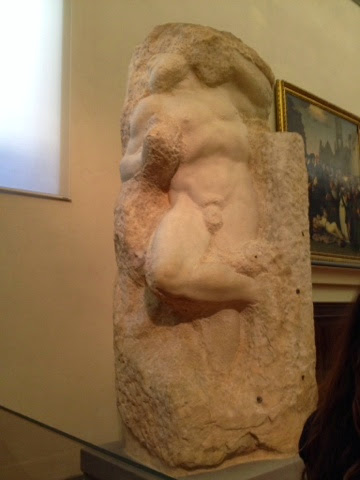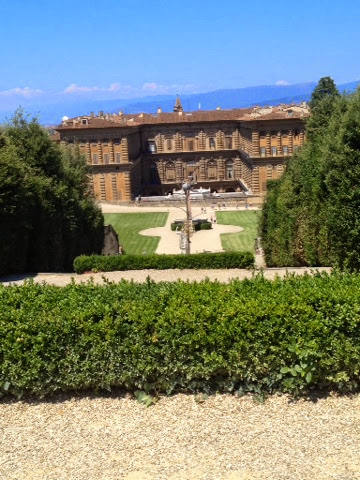Masculine. Stark. This is my first impression as we arrive at Firenze’s Santa Maria Novello railway station. One thing I’ve noticed as we travel Europe by train is I always prefer the place we’ve just left. It takes about a day to get into real time. Venice is so ethereal, so pastel, that I am especially struck by Firenze’s brown and gray stone presence. Off-put, even. Where is the city that has seduced people over the ages?
Maybe it is our first dinner of celestial grilled porcini…
Or sunset over the Arno River…
Or the lyrical language flowing over me.
Or the shops!
Seduction accomplished, and it doesn’t take 24 hours.
The next day at the Accademia, it is not so much Michelangelo’s David that captivates…
As his unfinished sculptures, powerful creations emerging from marble…arms reaching, bodies twisting, ribs rising and falling before our eyes.
My daughter tells me he was a notorious procrastinator, or maybe he couldn’t say no and took on too many commissions. His half-created beings remind us of the physicality of the sculptor’s art, the passion to wrest life from raw stone.
We will learn more about his career the following afternoon at the Uffizi Gallery, but that morning we walk across the Ponte Vecchio to the Palazzo Pitti.
The Medicis were the power players of Florence, but Eleonora di Toledo, wife of Cosimo I, was a wealthy, educated businesswoman in her own right, daughter of the Spanish King of Naples. Palazzo Vecchio was a citadel of power and majesty, yet she longed for a garden. And so, on the hills across the river, she built the Pitti.
By no means a simple country getaway, the brown stone palace has its own imposing majesty, with grand marble halls and lavish frescoes that display thrilling feats of perspective. Look at these columns – painted, not architectural.
The Pitti’s terraced gardens offer breathtaking views of the surrounding hillsides, red-tiled roofs and greenery, the famous dome of a city that has now become soft and gentle before my eyes.
Once sacred relics were the status symbols of the day. Inside the Chapel of Relics, an ornate silver casket contains the skeleton of St. Cesonius, dug up in Rome and shipped to Maria Maddalena, a Hapsburg, and later royal wife. (This is a view from the figure’s feet toward his crowned skull.)
The dizzying costume exhibit ends in the modern era with a wink at Chanel and Karl Lagerfeld.
Because we didn’t book in advance, our only way to visit the Uffizi is by tour. We are lucky to have a delightful guide, Katia, who makes history come alive with her art insider stories. A promising twelve-year-old, Michelangelo was brought into the Medici court and trained for greatness. He changed the color palette, now luminous and bright, and with his sculptor’s eye, brought in molded figures. A nativity painting commissioned by a prominent figure was deemed shocking for its representation of a flesh and blood Mary, and the man offered a lower price. Michelangelo said never mind, he’d keep it himself. Later when the man decided he wanted it after all, the artist demanded a higher price. A shrewd businessman, confident of his worth, he got it.
Also developed in the apprentice system, Leonardo was assigned to work on two little angels while his master painted Jesus and John the Baptist. A country boy and keen naturalist, da Vinci created lifelike cherubs with wings of individual feathers, so birdlike they might take off and fly. He also painted the clear river waters Jesus and John are standing in, ripply and filled with light. The story is that his master, seeing this work, said he would never paint again.
In another painting, Leonardo was criticized for making Mary’s arm too long when viewed straight-on. However he knew the corner in which it was to hang, and when viewed from a right side angle, the perspective is perfect.
The Uffizi was opened to the public, a revolutionary decision to bring what had been private art to the people. I can imagine the awe this must have inspired, akin to what we feel in the great Italian churches. Here is a glorious dome of seashells.
And aren’t these cherubs cute?
Summer in Italy is hot, but the evenings are grand. Like everyone we wander the cobbled lanes eating gelato…pausing in lively herb-scented squares. The air caresses, the river reflecting ancient bridges under an almost-full moon.
Our last night is filled with aching beauty. I feel Florence slipping from my grasp…I need more time.
Arrivederci, Firenze.
We are off to the Tuscan coast. http://dianarchambers.blogspot.com/2014/08/europe-by-train-11-tuscany-paradise.html


